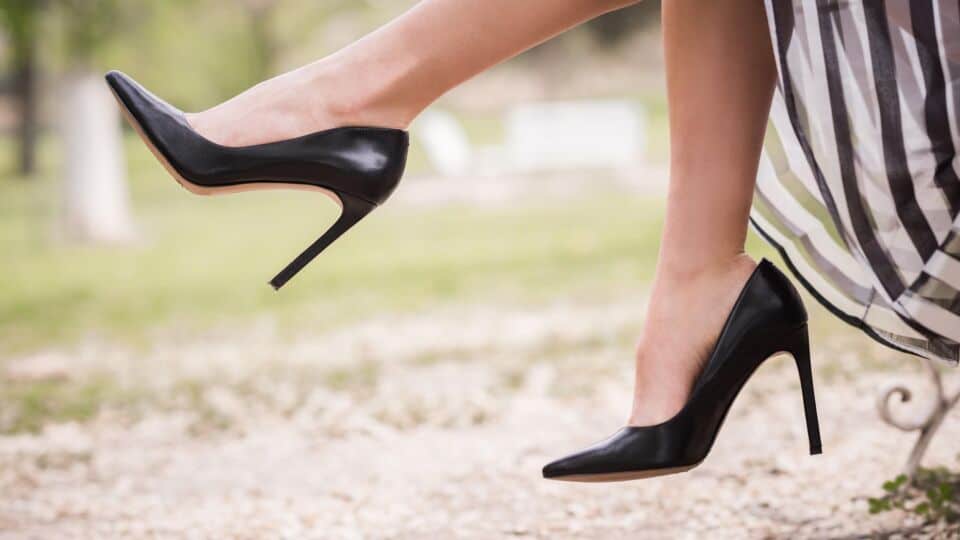Dangerous Elegance

The Love/Hate Relationship with High Heeled Shoes
High heeled shoes have been a part of women’s fashion for many years and they can make a good outfit. It has been said that high heels can make a woman look and feel sexy. But are they really worth it? Read on to find out the hidden dangers of wearing them and some tips to protect our feet when wearing them.
● 73% of Singaporeans are at risk of having knee osteoarthritis* because of certain lifestyle
habits.
● About 50% of Singaporeans have been or are affected by chronic knee pain.
● Nine out of 10 women are wearing shoes that are too small for their feet.
● Eight out of 10 women say that their shoes are painful.
● More than seven out of 10 women developed a bunion, hammertoe, or painful foot deformity.
● Women are nine times more likely to develop a foot problem because of improper fitting shoes than a man.
● Nine out of 10 women’s foot deformities can be attributed to tight shoes.
● Dancing in heels—no matter the height—tripled amount of pressure onto the toes.
*Osteoarthritis is a disorder affecting the joints of the skeleton, as it is a degenerative condition it is likely to worsen over time.
If wearing high heels are uncomfortable and they make walking difficult,
Then why in the world do all women keep wearing them?
Yes… the men don’t get it. Women feels especially good and attractive when they wear heels as it accentuates their curves at the right place by changing their posture, making them taller and slimmer i.e. having longer and toned legs. By elongating the legs it makes the calves appear more shapely and it changes the center of gravity from the heel to the ball of the feet therefore, forcing the butt and chest out for balance. This not only boosts women’s self-confidence but it also makes women look more attractive to men.
It probably comes with no surprise that that same pair of high heels force your back to arch and make the muscles in your back work overtime. This can leave the spine subject to injury or damage as it can significantly affect your natural posture and your spine. The muscles that support the lower back can become strained and cause aching or pain to arise. The common complaint that women have about back pains are largely caused by wearing high heel shoes.
According to Dr David Wong, Specialist in Spine & Orthopaedic Surgery, Raffles Orthopaedic Centre, putting your foot into a high heel shoe can have detrimental consequences on the overall health of your feet. High heel shoes place the heels unnaturally high above the toes and throw the whole body (knees, hips and back) totally out of alignment. In the long run, it can cause severe lower back pain and knee arthritis. This is when the spinal nerves can become pinched and pain, tingling and numb.
When the heel is constantly elevated, the entire weight of the body will be directed onto the ball of your foot, this can be especially dangerous for those who are overweight causing the ball of your foot to experience additional pressure. The joint cartilage that cushions the bones and allows the knee to move and bend wears away. When bones rub against each other, it causes inflammation, resulting in pain and swelling in the joints. In addition, the calf muscle and Achilles tendon can contract and shorten which increases the chances of Achilles tendinitis or shin splints. How sexy!
Dr Wong added, “Habitual wearing of extremely high heels can cause a woman to be unable to tolerate a flat shoe. High heels, especially stilettos and Lady Gaga type of shoes, will cause overall imbalance and instability when walking and it increases the risk of ankle sprains. On top of that, the tight fit of many heels will force the toes to conform to its shape. This added pressure on the toes can exacerbate bunions and hammertoes.” The long term risk include a permanent shortening of the Achilles tendon that runs up the back of the lower leg as constant wearing of high heels encourages the tendon to assume this shortened position permanently. Furthermore, Dr Wong says, “The compression of the metatarsal bones can cause pressure on the nerves that run between them.”
A Morton’s neuroma, which is a growth and inflammation of the nerve, can form due to the pressure. The toenails are not spared either. Toenails are also at risk from wearing high heels as the incidence of ingrown toenails and nail infections is higher in heel wearers that those who do not wear them as often. Ingrown toenails can be very painful, unsightly and required surgery to correct.
Tips to Protect Your Feet When Wearing High Heels
Although this is serious and shouldn’t be taken lightly, we know you love your high heels, so we won’t even try to get you sneakers. The key to avoiding is to be selective in the types of shoes you wear and how often you wear them. Here are some tips to protect your feet.
1.Get the best-fitting high heel possible
Dr Wong says, “High heels that don’t fit properly would cause the front of the foot to slide forward, creating more pressure and pain on the toes.” Look for narrow heels with a snug but not tight fit to correct the problem. To avoid toe injury and pain all together, pay attention to the shape of your shoes; square boxed heels would allow your feet to sit more naturally than in pointed ones. While some 4-inch heels will give you a straight drop down to the flatbed portion of the shoe, others will be a more gradual slope. This may be easier on the arch and might help relieve some pain in the ball of the foot.
Wedges are preferred as they provide more stability for the foot and less likely to injure as compared to stilettos and thin heels. Strapped heels are also better as it grips lesser of your toes.
2. Cushion, cushion, cushion
While soft insoles can give a little more support and cushioning for the foot and heel, if you have pain in the ball of the foot or you will be standing in your heels a long time, invest in silicone metatarsal pads. They look like flattened gummy bears, but they do a super job of shock absorption.
3. Choose a thicker heel for stability
“It is safer to use platform shoes or thicker heels of about 2 inches as it allows more comfort and it provides more stability,” Dr Wong advises. A thicker heel will give you better balance and may help relieve some pressure by distributing the weight on your foot more evenly. Alternating heel heights can also help reduce problems with the Achilles tendon.
According to Ms Lucie, reducing the use of heels by wearing a pair of flats to travel to work and slipping on heels when in office is recommended. As rushing around in heels can become uncomfortable very quickly, use high heels for special occasions rather than on a regular or daily basis. Carrying a pair of flat comfortable shoes with you to change into after hours of wearing heels also helps. Using them less frequently will reduce the long-term effects of high heels.
3. Wear open-toe high heels to relieve pressure on corns and calluses.
See a podiatrist to have corns and calluses professionally removed and correct the problem that’s causing them. But if that’s not possible, opt for open-toe shoes to take pressure off inflamed areas.
4. Be Sure to Stretch
Not only good for preventing osteoporosis, exercise is essential in maintaining almost all of the bodies functions. Ms Lucie said, “By doing weight-bearing exercises, minerals in bones will have to work harder and over time it will become stronger. Hence, allow your calf to stretch when you are sitting at your desk.”
Doing poses such as high and low lunge and standing forward fold will stretch your calves, hip flexors and hamstring muscles. Taking part in resistance exercise helps to strengthen the muscles and ligaments that support the skeleton that in turn will help strengthen bones. These exercises would especially benefit older generations who may not be able to participate frequently in weight-bearing or high impact activities.



